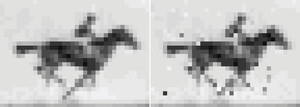
Seth Shipman / Harvard University
Original image (left) and the image recomposed using data recovered from bacterial DNA (right)Seth Shipman / Harvard UniversityThe images below of a person riding a horse are part of a short video made with information retrieved from material that has never before been used for such a purpose: DNA molecules. Geneticists at Harvard University used DNA snippets to encode the black and white pixel values of an image of a galloping horse, created in 1878 by English photographer Eadweard Muybridge (1830-1904). They then inserted these snippets into the DNA of bacteria using the CRISPR-Cas genome-editing technique (see Pesquisa FAPESP, issue No. 240), and the bacteria transmitted the information to their offspring when they reproduced. The researchers were able to retrieve the data encoded in the genome of the bacteria and recreate the film with 90% accuracy (Nature, July 12). The experiment highlights the possibility of using live cells to store information. Using such techniques, bacteria could potentially be turned into living environmental monitors, keeping records of heavy metals and other pollutants. “What we are trying to develop is a molecular recorder that can sit inside living cells and collect data over time,” geneticist Seth Shipman, the study’s author, told British newspaper The Guardian. This way, neurons could be programmed to record information from the brain as it develops.
Republish
